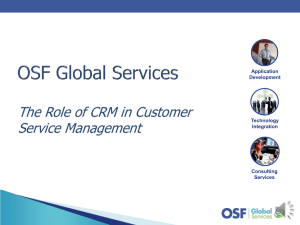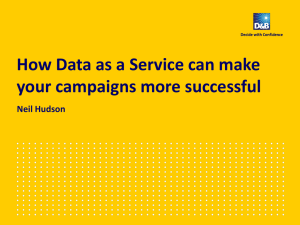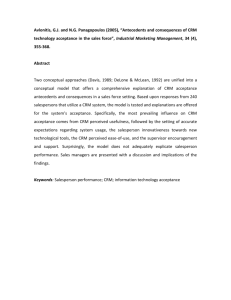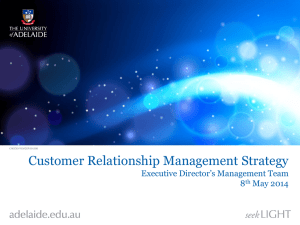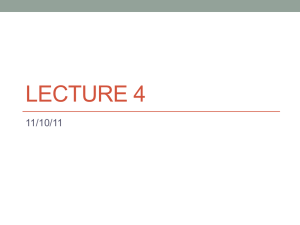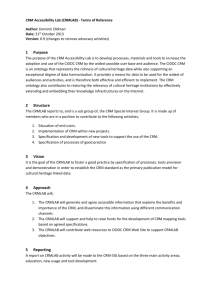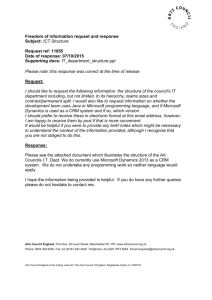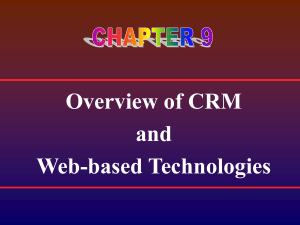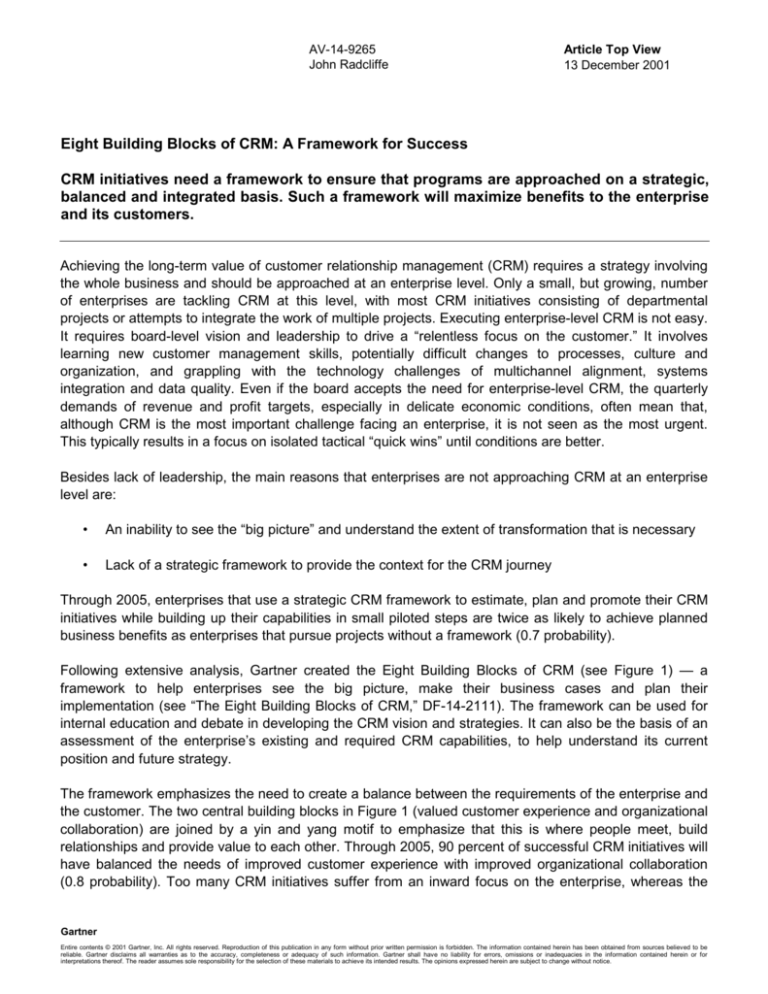
AV-14-9265
John Radcliffe
Article Top View
13 December 2001
Eight Building Blocks of CRM: A Framework for Success
CRM initiatives need a framework to ensure that programs are approached on a strategic,
balanced and integrated basis. Such a framework will maximize benefits to the enterprise
and its customers.
Achieving the long-term value of customer relationship management (CRM) requires a strategy involving
the whole business and should be approached at an enterprise level. Only a small, but growing, number
of enterprises are tackling CRM at this level, with most CRM initiatives consisting of departmental
projects or attempts to integrate the work of multiple projects. Executing enterprise-level CRM is not easy.
It requires board-level vision and leadership to drive a “relentless focus on the customer.” It involves
learning new customer management skills, potentially difficult changes to processes, culture and
organization, and grappling with the technology challenges of multichannel alignment, systems
integration and data quality. Even if the board accepts the need for enterprise-level CRM, the quarterly
demands of revenue and profit targets, especially in delicate economic conditions, often mean that,
although CRM is the most important challenge facing an enterprise, it is not seen as the most urgent.
This typically results in a focus on isolated tactical “quick wins” until conditions are better.
Besides lack of leadership, the main reasons that enterprises are not approaching CRM at an enterprise
level are:
•
An inability to see the “big picture” and understand the extent of transformation that is necessary
•
Lack of a strategic framework to provide the context for the CRM journey
Through 2005, enterprises that use a strategic CRM framework to estimate, plan and promote their CRM
initiatives while building up their capabilities in small piloted steps are twice as likely to achieve planned
business benefits as enterprises that pursue projects without a framework (0.7 probability).
Following extensive analysis, Gartner created the Eight Building Blocks of CRM (see Figure 1) — a
framework to help enterprises see the big picture, make their business cases and plan their
implementation (see “The Eight Building Blocks of CRM,” DF-14-2111). The framework can be used for
internal education and debate in developing the CRM vision and strategies. It can also be the basis of an
assessment of the enterprise’s existing and required CRM capabilities, to help understand its current
position and future strategy.
The framework emphasizes the need to create a balance between the requirements of the enterprise and
the customer. The two central building blocks in Figure 1 (valued customer experience and organizational
collaboration) are joined by a yin and yang motif to emphasize that this is where people meet, build
relationships and provide value to each other. Through 2005, 90 percent of successful CRM initiatives will
have balanced the needs of improved customer experience with improved organizational collaboration
(0.8 probability). Too many CRM initiatives suffer from an inward focus on the enterprise, whereas the
Gartner
Entire contents © 2001 Gartner, Inc. All rights reserved. Reproduction of this publication in any form without prior written permission is forbidden. The information contained herein has been obtained from sources believed to be
reliable. Gartner disclaims all warranties as to the accuracy, completeness or adequacy of such information. Gartner shall have no liability for errors, omissions or inadequacies in the information contained herein or for
interpretations thereof. The reader assumes sole responsibility for the selection of these materials to achieve its intended results. The opinions expressed herein are subject to change without notice.
point of CRM is to achieve a balance between value to shareholders or stakeholders and value to
customers for mutually beneficial relationships.
Figure 1
The Eight Building Blocks of CRM
1. CRM Vision: Leadership, Market Position, Value Proposition
2. CRM Strategy: Objectives, Segments, Effective Interaction
3. Valued Customer
Experience
Understand Requirements
Monitor Expectations
Satisfaction vs. Competition
Collaboration and Feedback
Customer Communication
4. Organizational Collaboration
Culture and Structure
Customer Understanding
People: Skills, Competencies
Incentives and Compensation
Employee Communications
Partners and Suppliers
5. CRM Processes: Customer Life Cycle, Knowledge Management
6. CRM Information: Data, Analysis, One View Across Channels
7. CRM Technology: Applications, Architecture, Infrastructure
8. CRM Metrics: Value, Retention, Satisfaction, Loyalty, Cost to Serve
Source: Gartner Research
In this Spotlight, we drill down into the Eight Building Blocks of CRM — vision, strategy, valued customer
experience, organizational collaboration, processes, information, technology and metrics — providing
more detail and fleshing out the framework.
1. Vision: Successful CRM demands a clear vision so that a strategy and implementation can be
developed to achieve it. The CRM vision is how the customer-centric enterprise wants to look and feel to
its customers and prospects — the customer value proposition (CVP) and the corporate brand values are
key to the CRM vision. Without a CRM vision, the enterprise will not stand out from the competition,
target customers will not know what to expect from it and employees will not know what to deliver in terms
of external customer experience. A successful CRM vision is the cornerstone to motivating staff,
generating customer loyalty and gaining a greater market share. “Creating a CRM Vision” (TG-14-9470)
defines a CRM vision, outlines the key steps and challenges in creating it and discusses its role in
creating a successful CRM program.
2. Strategy: A CRM strategy is not an implementation plan or road map. A real CRM strategy takes the
direction and financial goals of the business strategy and sets out how the enterprise is going to build
customer loyalty — that “feel-good factor” of customer connection with an enterprise that means
customers stay longer, buy more, recommend the enterprise to others and are more willing to pay a
premium price. The objectives of a CRM strategy are to target, acquire, develop and retain valuable
customers to achieve corporate goals. “Developing a CRM Strategy” (TU-14-9475) discusses the steps
involved in the development of the CRM strategy.
Copyright 2001
AV-14-9265
13 December 2001
2
3. Valued Customer Experience: Customers’ experiences when interacting with the enterprise play a
key role in shaping their perception of the enterprise — the value it provides and the importance it places
on the customer relationship. Good customer experiences drive satisfaction, trust and long-term loyalty.
Poor customer experiences have the opposite effect and, because bad news travels faster and further
than good news, they harm the enterprise’s ability to create new relationships with prospects. No amount
of internal “second guessing” can simulate what it’s really like to be a customer. “Customer Experience:
The Voice of the Customer” (TG-14-9567) focuses on the need to seek and act on customer feedback to
create and maintain a successful customer experience.
4. Organizational Collaboration: Many enterprises believe that implementing CRM technologies makes
them a customer-centric organization. They forget, ignore or deliberately avoid the necessary changes to
the enterprise itself. True CRM means that individuals, teams and the whole enterprise must become
more focused on the needs and wants of the customer. The term “organizational collaboration,”
described in “True CRM Requires Organizational Collaboration” (DF-14-6658), highlights the many facets
of the customer-centric internal change needed to deliver the required and desired external customer
experience. As a critical part of a CRM program, it will involve changing organizational structures,
incentives and compensation, skills and even the enterprise culture. Ongoing change management will
be key.
5. Processes: Past efforts to re-engineer processes were primarily driven by the desire to improve the
efficiency of an enterprise and reduce costs. The beneficiary was the enterprise, not its customers. The
rise in CRM has led to a focus on reworking key processes that touch the customer and asking
customers which processes matter to them. We call this customer process re-engineering (discussed in
“Customer Process Re-engineering: Talk to Your Customers,” DF-14-8380). Enterprises frequently do not
realize that their functionally fragmented processes often mean that the customer has a poor experience
and receives less than the expected value. Successful re-engineering should create processes that not
only meet customers’ expectations, but also support the customer value proposition, provide competitive
differentiation and contribute to the desired customer experience.
6. Information: Successful CRM requires a flow of customer information around the organization and
tight integration between operational and analytical systems. Having the right information at the right time
is fundamental to successful CRM strategies, providing customer insight and allowing effective interaction
across any channel. Unfortunately, most enterprises’ CRM information capabilities are poor — the result
of numerous and fragmented departments, initiatives, databases and systems. Enterprises that establish
a business plan for sourcing, managing and leveraging their customer information assets are more likely
to achieve their CRM goals and objectives and gain a competitive advantage (see “Customer Information
Is the Lifeblood of CRM,” DF-14-9264).
7. Technology: For most technologists, CRM is all about technology. CRM technologies are an essential
enabler for any modern CRM business strategy, but they are just one piece of the puzzle. Gartner has a
wealth of ongoing research into CRM technology issues and “Technology Decisions Are Key to Enabling
CRM Strategies” (DF-14-8082) looks at the key decisions that enterprises have to take in three areas:
CRM applications, architectural issues and integration. In many CRM projects, integration issues start as
a relatively low priority, and then rise in prominence (cost and time) as enterprises realize that true CRM
requires seamless customer-centric processes, supported by integrated technology across the enterprise
and its supply chain.
8. Metrics: The other seven building blocks depend on performance targets and metrics to gauge their
success, and enterprises must set measurable CRM objectives and monitor CRM indicators to
successfully turn customers into assets. Without performance management, a CRM strategy and
Copyright 2001
AV-14-9265
13 December 2001
3
associated program is destined to fail. “Getting the Best Out of CRM Performance Metrics” (DF-13-1433)
introduces a framework for measuring an enterprise’s success with CRM by creating a hierarchy of
performance metrics with four levels, namely: corporate, customer strategic, operational and process,
and infrastructure input metrics. These metrics have an internal and an external focus and link operations
to strategy and corporate financial benefits. Each enterprise will have a unique set of metrics applicable
to their situation.
Features
“Creating a CRM Vision” (TG-14-9470). Defines what a CRM vision is, discusses its role in setting the
stage for creating a successful CRM program and outlines the key steps and challenges. By Jennifer
Kirkby
“Developing a CRM Strategy” (TU-14-9475). Provides guidance on the main steps in the development of
a CRM business strategy. By Jennifer Kirkby
“Customer Experience: The Voice of the Customer” (TG-14-9567). Defines a customer experience and
discusses how to design a customer experience that is mutually beneficial for the enterprise and its
customers. By Jennifer Kirkby, Ed Thompson and Joel Wecksell
“True CRM Requires Organizational Collaboration” (DF-14-6658). Discusses the many facets of internal
change needed to deliver the required external customer experience and highlights the need for ongoing
change management. By John Radcliffe, Ed Thompson and Beth Eisenfeld
“Customer Process Re-engineering: Talk to Your Customers” (DF-14-8380). Introduces the concept of
customer process re-engineering with its focus on reworking key processes that touch the customer,
based on customer input. By Ed Thompson
“Customer Information Is the Lifeblood of CRM” (DF-14-9264). Argues the case for thinking strategically
about sourcing, managing and leveraging customer information assets to better achieve CRM goals and
objectives. By John Radcliffe, Kimberly Collins and Jennifer Kirkby
“Technology Decisions Are Key to Enabling CRM Strategies” (DF-14-8082). Breaks the CRM technology
space down into applications, architecture and integration and discusses the main challenges, trends and
recommendations at a high level. By John Radcliffe and Jeff Comport
“Getting the Best Out of CRM Performance Metrics” (DF-13-1433). Introduces a framework, based on a
hierarchy of performance metrics with four levels, for measuring an enterprise’s success in meeting the
objectives of its CRM strategy. By Jennifer Kirkby, Ed Thompson and Frank Buytendijk
Copyright 2001
AV-14-9265
13 December 2001
4

